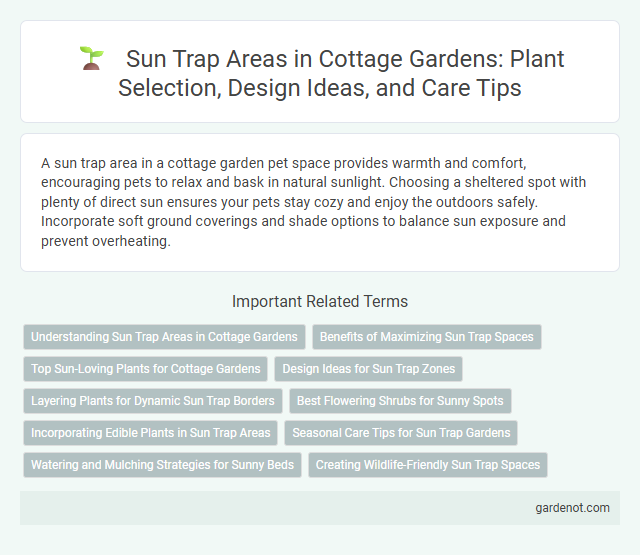A sun trap area in a cottage garden pet space provides warmth and comfort, encouraging pets to relax and bask in natural sunlight. Choosing a sheltered spot with plenty of direct sun ensures your pets stay cozy and enjoy the outdoors safely. Incorporate soft ground coverings and shade options to balance sun exposure and prevent overheating.
Understanding Sun Trap Areas in Cottage Gardens
Sun trap areas in cottage gardens are spots that receive prolonged, direct sunlight, creating a warm microclimate ideal for sun-loving plants like lavender, rosemary, and roses. These zones maximize sunlight exposure by being sheltered from strong winds using walls, fences, or dense planting, enhancing plant growth and bloom intensity. Understanding and utilizing sun trap areas boosts garden productivity and aesthetic appeal by supporting heat-tolerant species that thrive in bright, warm conditions.
Benefits of Maximizing Sun Trap Spaces
Maximizing sun trap areas in a cottage garden enhances plant growth by providing optimal warmth and light, fostering vibrant blooms and healthier foliage. These spaces extend the growing season, allowing gardeners to cultivate a wider variety of sun-loving plants and herbs. Increased sunlight exposure also supports pollinator activity, boosting biodiversity and garden productivity.
Top Sun-Loving Plants for Cottage Gardens
Sun trap areas in cottage gardens are ideal for cultivating top sun-loving plants such as lavender, sedum, and echinacea. These species thrive in full sunlight, offering vibrant colors and attracting pollinators like bees and butterflies. Incorporating drought-tolerant varieties like thyme and coreopsis ensures resilient growth in warm, sunny conditions.
Design Ideas for Sun Trap Zones
Creating a sun trap zone in a cottage garden involves selecting heat-loving plants such as lavender, rosemary, and sedum that thrive in direct sunlight and well-drained soil. Incorporate natural materials like warm-toned stone pathways and wooden benches to enhance the cozy, inviting atmosphere while maximizing sunlight reflection. Positioning trellises with climbing roses or honeysuckle adds vertical interest and softens the space, making it an ideal sun-soaked retreat.
Layering Plants for Dynamic Sun Trap Borders
Layering plants in a sun trap area creates dynamic borders by combining height, texture, and color that thrive in full sun. Taller plants like lavenders and ornamental grasses provide structure, while mid-height perennials such as geraniums and salvia add vibrant blooms. Low-growing ground covers like thyme and creeping phlox fill gaps, enhancing visual interest and maximizing sunlight exposure in your cottage garden.
Best Flowering Shrubs for Sunny Spots
Choosing the best flowering shrubs for sunny spots in a sun trap area enhances a cottage garden's vibrant appeal and seasonal interest. Lavender, butterfly bush (Buddleja), and rose varieties thrive in full sun, offering fragrant blooms and attracting pollinators like bees and butterflies. Incorporating drought-tolerant shrubs such as spirea and potentilla ensures low maintenance while providing colorful blossoms throughout the growing season.
Incorporating Edible Plants in Sun Trap Areas
Sun trap areas in cottage gardens provide an ideal microclimate for growing heat-loving edible plants such as tomatoes, peppers, and herbs like basil and rosemary. Utilizing south-facing walls or sheltered spots increases warmth and extends the growing season, allowing for a bountiful harvest. Incorporating edible plants into these sunny niches enhances garden productivity while maintaining the natural charm and biodiversity of the cottage garden design.
Seasonal Care Tips for Sun Trap Gardens
Sun trap areas in cottage gardens require seasonal care to maximize plant health and bloom performance. In spring, prepare soil with organic compost and control weeds to ensure strong root development under intense sunlight. During summer, maintain consistent watering and mulching to prevent soil drying, while pruning sun-loving shrubs promotes air circulation and vibrant flowering.
Watering and Mulching Strategies for Sunny Beds
Effective watering in sun trap areas involves deep, infrequent irrigation to encourage strong root growth and reduce water evaporation. Applying organic mulch such as wood chips or straw helps retain soil moisture, suppress weeds, and regulate soil temperature in sunny beds. Combining these strategies promotes healthy plant development and conserves water in cottage garden environments.
Creating Wildlife-Friendly Sun Trap Spaces
Sun trap areas in cottage gardens provide warm, sheltered spots that attract pollinators such as bees and butterflies by offering abundant nectar-rich plants like lavender, echinacea, and sedum. Incorporating native grasses, flowering shrubs, and a shallow water source encourages diverse wildlife, from ladybugs to small birds, enhancing ecological balance. Using natural materials like stone and reclaimed wood for borders and logs for insect habitats supports microhabitats that thrive in sunny, protected niches.
Sun trap area Infographic

 gardenot.com
gardenot.com